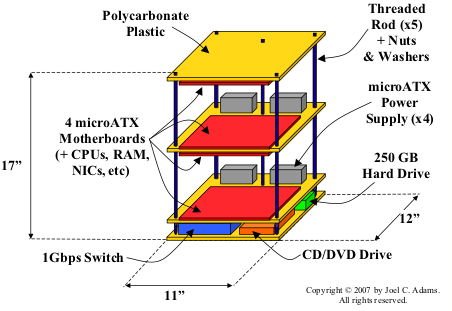Microwulf: Design
Microwulf is designed to be a cost-efficient,
high performance, portable, "personal" Beowulf cluster.
The basic idea is to pack a lot of processing power into a
small volume using multicore CPUs.

|
To do so, we use motherboards with
a smaller form-factor
(like Little Fe)
than the usual ATX size,
and we space them using threaded rods
(like this cluster)
and scrap plexiglass, to minimize "packaging" costs.
By building a "double decker sandwich" of
four microATX motherboards, each with
a dual core CPU and
2 GB RAM (1 GB/core),
we can build a 4-node, 8-core, 8GB multiprocessor
small enough to fit on one's desktop,
powerful enough to do useful work,
and inexpensive enough that anyone can afford one.
Since our microATX motherboards have an on-board Gigabit Ethernet
adaptor, that is the least expensive way for the processors
to communicate.
To keep the two cores from competing for this adaptor,
we add a second Gigabit Ethernet adaptor in each motherboard's
PCI-Express slot.
We then rely on Open MPI (see below)
to spread the communication load across these two adaptors.
Then we connect all the adpators via
an inexpensive 8-port Gigabit Ethernet switch.
This provides a Gigabit Ethernet link's worth of bandwidth
for each core.
|
The bottom motherboard acts as the "master" node,
which is configured to boot from Microwulf's single hard disk
(and/or DVD-ROM drive).
The other three motherboards are configured as "server" nodes,
and boot from the network using PXE.
The following schematic diagram shows the interconnections between
Microwulf's components:

At present, Microwulf is running
Ubuntu Linux.
Open MPI will sense the network adaptors in a node,
and then round-robin the communications between them.
To try to help Open MPI spread the load on both the
sending and receiving side, we configured the on-board
adaptors to be part of a 192.168.2.x subnet,
and the PCI-e adaptors to be part of a 192.168.3.x subnet.
Joel Adams >
Research >
Microwulf >
Design

